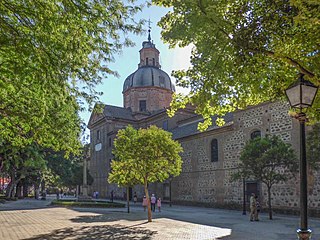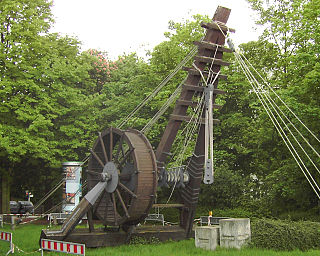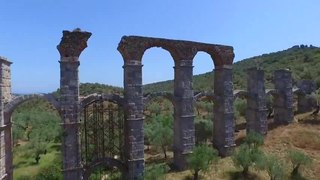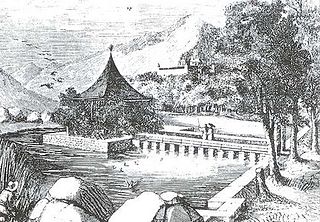Related Research Articles

The Tagus is the longest river in the Iberian Peninsula. The river rises in the Montes Universales in mid-eastern Spain, flows 1,007 km (626 mi), generally west with two main south-westward sections, to empty into the Atlantic Ocean near Lisbon. Its drainage basin covers 80,100 square kilometers (30,927 sq mi) – exceeded in the peninsula only by the Douro. The river is highly used. Several dams and diversions supply drinking water to key population centres of central Spain and Portugal; dozens of hydroelectric stations create power. Between dams it follows a very constricted course, but after Almourol, Portugal it has a wide alluvial valley, prone to flooding. Its mouth is a large estuary culminating at the major port, and Portuguese capital, Lisbon.

Segovia is a compact Spanish city in the south-east of the autonomous community of Castile and León. It is the capital and most populated municipality of the Province of Segovia.

Talavera de la Reina is a city and municipality of Spain, part of the autonomous community of Castile–La Mancha. Its population of 83,303 makes it the second most populated municipality of the province of Toledo and the fourth largest in the region.

Monfragüe is a Spanish national park noted for its bird-life. It is situated in the center of a triangle formed by Plasencia, Trujillo and the city of Cáceres within the province of Cáceres. Monfragüe is also a comarca of Extremadura, western Spain.

The ancient Romans were famous for their advanced engineering accomplishments. Technology for bringing running water into cities was developed in the east, but transformed by the Romans into a technology inconceivable in Greece. The architecture used in Rome was strongly influenced by Greek and Etruscan sources.

Augusta Emerita, also called Emerita Augusta, was a Roman Colonia founded in 25 BC in present day Mérida, Spain. The city was founded by Roman Emperor Augustus to resettle Emeriti soldiers from the veteran legions of the Cantabrian Wars, these being Legio V Alaudae, Legio X Gemina, and possibly Legio XX Valeria Victrix. The city was the capital of the Roman province of Lusitania, and was one of the largest in Hispania with an area of over 20,000 square kilometres (7,700 sq mi). It had three aqueducts and two fora.

The Romans constructed aqueducts throughout their Republic and later Empire, to bring water from outside sources into cities and towns. Aqueduct water supplied public baths, latrines, fountains, and private households; it also supported mining operations, milling, farms, and gardens.

Alcantarilla is a town and municipality in southeastern Spain, in the Autonomous Community of the Region of Murcia. The town is only 7 km away from the capital of the region, the city of Murcia, and one of its peculiarities is that it is completely surrounded by "pedanías" of the municipality of Murcia like Sangonera La Seca, San Ginés, Nonduermas, Puebla de Soto, La Ñora, Javalí Viejo and Javalí Nuevo.

La Fresneda is a park in El Escorial, Community of Madrid, Spain. Built between 1561 and 1569, it was the prívate Royal Park of Philip II in the surroundings of the Monastery of El Escorial.

The Artificio de Juanelo was the name of two devices built in Toledo in the 16th century by Juanelo Turriano. They were designed to supply the city with a source of readily available water by lifting it from the Tagus (Tajo) river to the Alcázar. Now in ruins, the precise details of the operation of the devices are unknown, but at the time they were considered engineering wonders.

Mazarambroz is a municipality located in the province of Toledo, Castile-La Mancha, Spain. According to the 2006 census (INE), the municipality has a population of 1314 inhabitants.

The Cornalvo Dam is a Roman gravity dam in Badajoz province, Extremadura, Spain, dating to the 1st or 2nd century AD. The earth dam with stone cladding on the water face is still in use.

The Proserpina Dam is a Roman gravity dam in Badajoz (province), Extremadura, Spain, dating to the 1st or 2nd century AD. It was built as part of the infrastructure which supplied the city of Emerita Augusta with water.
The Alcantarilla Dam is a ruined Roman gravity dam in Mazarambroz, Toledo province, Castilla-La Mancha, Spain, dating to the 1st century AD. The toponym "Alcantarilla" means conduit and is of Arabic origin: the Latin name is unknown.

The Puente de Alcántara is a Roman arch bridge in Toledo, Spain, spanning the Tagus River. The word Alcántara comes from Arabic القنطرة (al-qanţarah), which means "arch".

An aqueduct is a watercourse constructed to carry water from a source to a distribution point far away. In modern engineering, the term aqueduct is used for any system of pipes, ditches, canals, tunnels, and other structures used for this purpose. The term aqueduct also often refers specifically to a bridge carrying an artificial watercourse. Aqueducts were used in ancient Greece, ancient Egypt, and ancient Rome. In modern times, the largest aqueducts of all have been built in the United States to supply large cities. The simplest aqueducts are small ditches cut into the earth. Much larger channels may be used in modern aqueducts. Aqueducts sometimes run for some or all of their path through tunnels constructed underground. Modern aqueducts may also use pipelines. Historically, agricultural societies have constructed aqueducts to irrigate crops and supply large cities with drinking water.

View and Plan of Toledo is a landscape painting by El Greco. The image is notable for its juxtaposition of the view of Toledo with the trompe l'oeil map of the city's streets. In the composition, El Greco also included an allegory of the Tagus River, a scene of the Virgin Mary placing a chasuble on Saint Ildefonsus, and an elevation of the Tavera Hospital floating on a cloud. It was probably originally commissioned by Pedro Salazar de Mendoza and is currently preserved in the El Greco Museum in Toledo, Spain.

The Caños de Carmona are the remains of a Roman aqueduct 17.5 kilometres long, later rebuilt by the Almohads, which connected the cities of Carmona and Seville, and which was fully operational until its demolition in 1912.
The Roman baths of Toledo or Roman thermae of Amador de los Ríos are ruins of Roman thermae located in the city of Toledo in Castile-La Mancha, Spain. The baths can be seen as part of the system of supplying clean water to the city. From the scale of the surviving infrastructure, they are assumed to have been a public facility.

The Oratory of Saint Philip Neri is a former church in Toledo. The building was used by the Congregation of the Oratory of Saint Philip Neri as an oratory (chapel). From 2013 it housed the Tolmo Museum, but as at 2018 it is reported to be closed.
References
- ↑ Spann, P. "Places: 266066 (Toletum)". Pleiades. Retrieved 2018-05-17.
- 1 2 "Restos del acueducto" [Remains of the aqueduct] (in Spanish). Retrieved 2018-05-29.
- ↑ Gomez, I (1995). "Toledo beberá del mismo embalse que suministra a Madrid". El Pais (in Spanish).
- 1 2 consorciotoledo.com (2014). EN TORNO A LA RED ROMANA DE ABASTECIMIENTO DE AGUA A TOLEDO: Excavaciones en los terrenos de la ACADEMIA MILITAR DE INFANTERÍA [Roman water supply to Toledo (Spain): excavations in the fields of the Toledo Infantry Academy ] (in Spanish). ISSN 0514-7336.
- ↑ "Greek and Roman Siphons" . Retrieved 2018-05-29.


